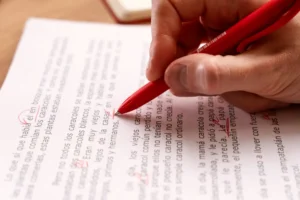Revising a translation is fundamental if you want a high-quality, accurate result. While many think translation is a single, definitive process, it actually involves several stages, including translation revision and correction. Without thorough revision, even a well-executed translation can fall short in terms of accuracy, style, or tone, which can negatively affect its impact and clarity.
Many people are unaware that translation revision is a key part of the process, regulated by European standard ISO 17100:2015, which defines the requirements for translation services. This standard ensures that translation service providers meet specific criteria, especially in areas like quality control, competence of translators and revisers, and the processes for translation and revision. Adhering to these guidelines helps ensure that revisions maintain a high level of quality and professionalism across the industry.
Do you know what translation revision involves and when it is needed? Read on to find out.
What does translation revision involve?
A revision is an examination or review of a translation by a translator other than the one who completed the initial translation. This step is essential to ensure objectivity. A fresh pair of eyes often catches issues that the original translator might have missed due to familiarity with the text. This second translator typically specializes in the target language and has experience in the subject matter in question.
The main purposes of a revision are to correct any errors that may be present, such as mistranslations, grammatical mistakes, or misinterpretations, and to fine-tune the translation for maximum quality. The revising translator examines all aspects of the composition, including vocabulary, grammar, tone, and style. This stage ensures that the text flows naturally, is cohesive, and reflects the original meaning accurately while considering cultural and linguistic nuances.
Additionally, a well-executed revision can often enhance a translation beyond mere error correction. It can involve improving phrasing, refining terminology to better suit the subject matter, and ensuring consistency throughout the document.
Stages of a translation revision
A complete revision includes two fundamental stages: the monolingual revision and the bilingual revision. Both are essential for guaranteeing that the translation is both accurate and stylistically appropriate.
Bilingual revision

This stage is particularly important for technical or highly specialized documents, where the precise meaning of terms is crucial. For instance, in legal, medical, or engineering texts, even a minor mistranslation could lead to significant consequences, such as misunderstanding instructions or misinterpreting regulations.
Monolingual revision
The monolingual revision focuses exclusively on the target text, without comparing it directly to the source text. In this stage, the reviser treats the translation as an independent document, ensuring that it reads fluently and naturally in the target language. The aim is to confirm that the text conforms to the client’s preferences, complies with the linguistic standards of the respective language, and follows the chosen style guide.
A good monolingual revision also checks for tone and style appropriateness, ensuring that the translation serves its intended purpose effectively, whether it’s for formal publications, marketing materials, or internal communications.
To facilitate the revision process, revisers often use a track change system. This tool makes suggested changes visible, allowing for easier collaboration and final approval by the client or original translator. It also helps ensure uniformity and cohesion throughout the text.
When should you seek out the revision of a translation?
While translation revision is an integral part of any professional translation process, there are specific situations where it becomes absolutely essential.
One clear example is when a translation is intended for publication. For instance, manuals, brochures, posters, menus, or any text aimed at a large audience must be error-free and effective in delivering its message. Even minor errors in these types of documents can lead to misunderstandings, damage credibility, or diminish the professional image of a company or organization.
In the case of more specialized texts, such as business letters, scientific papers, or technical presentations, a revision by a translator who is well-versed in the subject matter is highly recommended. Specialized terminology must be accurate, and any mistakes could have a serious impact on the credibility of the document.
Another scenario where revision is recommended is when the final translation does not meet the client’s expectations. In such cases, a revision offers the opportunity to address concerns, refine the text further, and ensure client satisfaction.
Although the need for translation revision may vary depending on the type of text, the availability of translators, and the client’s requirements and budget, it remains a critical part of the translation process. Revision is not just about fixing mistakes; it’s about elevating the quality of the translation, ensuring that it is clear, coherent, and professionally tailored to its intended audience.
Ultimately, translation revision offers a guarantee that your text will be accurate, polished, and fully aligned with the original content, providing peace of mind that the final product will effectively serve its purpose.


